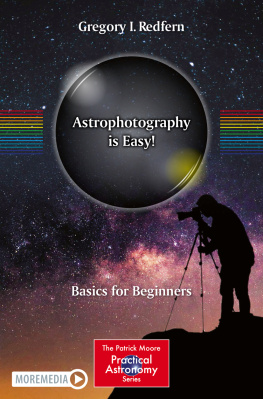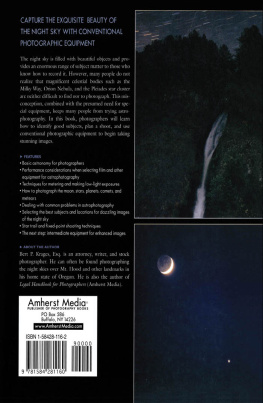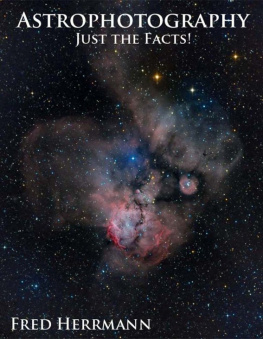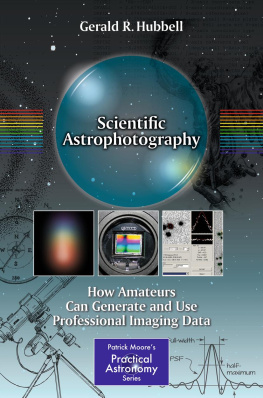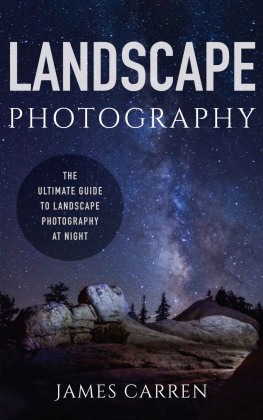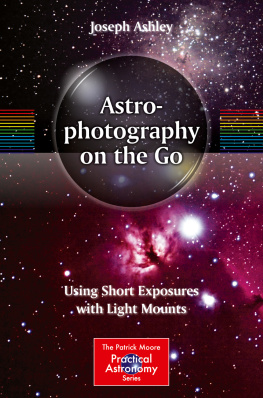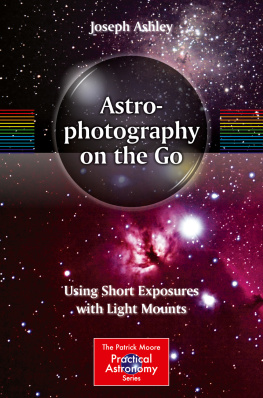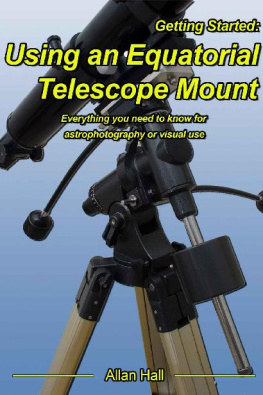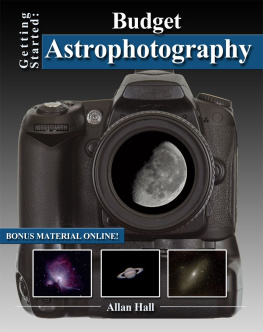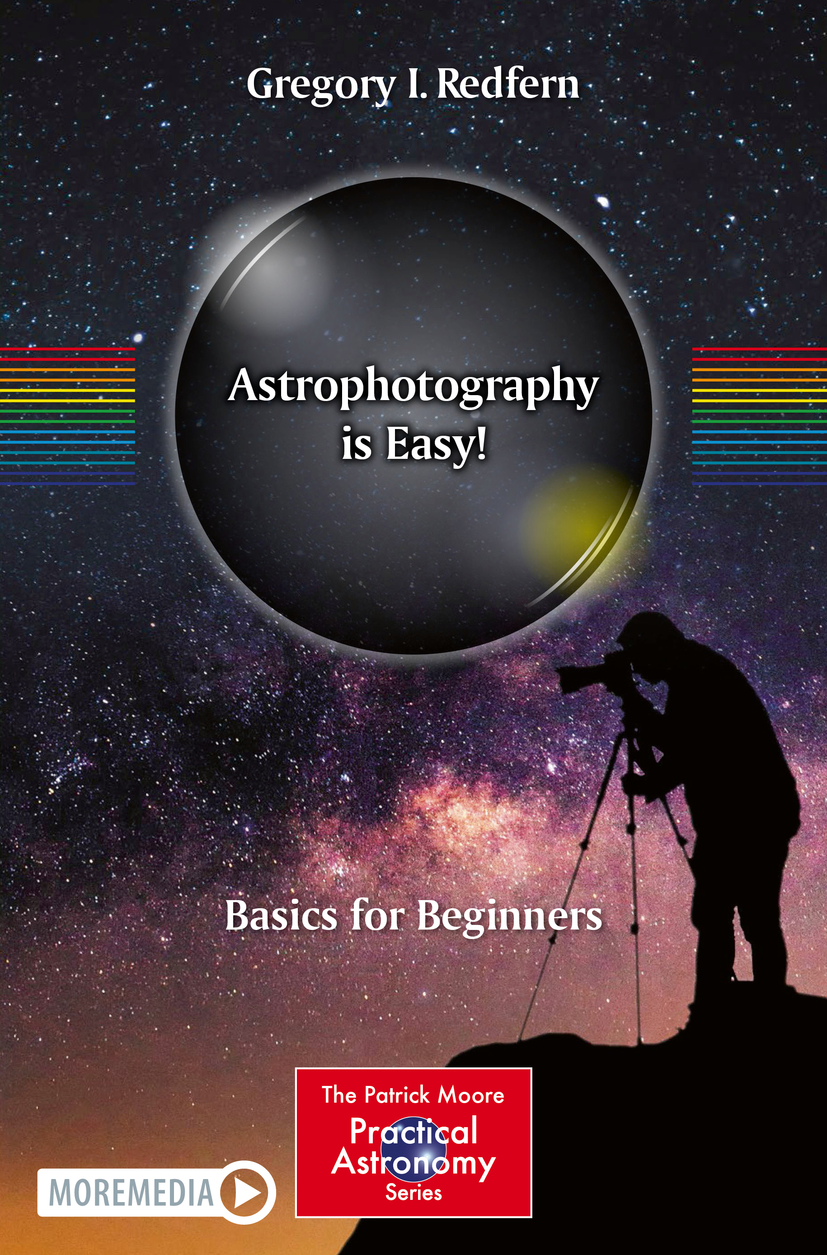The Patrick Moore Practical Astronomy Series
Series Editor
Gerald R. Hubbell
Mark Slade Remote Observatory, Locust Grove, VA, USA
More information about this series at The Patrick Moore Practical AstronomySeries http://www.springer.com/series/3192 is a treasure trove of how-to guides for the amateur astronomer. The books in this series are written for hobbyists at all levels, from the enthusiastic newcomer to the veteran observer. They thus go far beyond more general, popular-level books in both scope and depth, exploring in detail the latest trends, techniques, and equipment being used by amateur astronomers around the world.
You will find herein a diverse list of books on constellations, astronomy catalogues, astrophotography, eclipse chasing, telescope equipment, software, and so much more. All books in the series boast full-color images as well as practical sections for putting your newfound knowledge to use, including star charts and target objects, glossaries, hands-on DIY projects, troubleshooting walk-throughs, and a plethora of other helpful features.
Overall, this series bridges the gap between the many introductory books available and more specialized technical publications, providing digestible, hands-on guides for those wishing to expand their knowledge of the night skies.
Gregory I. Redfern
Astrophotography is Easy!
Basics for Beginners
1st ed. 2020
Gregory I. Redfern
Ruckersville, VA, USA
ISSN 1431-9756 e-ISSN 2197-6562
The Patrick Moore Practical Astronomy Series
ISBN 978-3-030-45942-0 e-ISBN 978-3-030-45943-7
https://doi.org/10.1007/978-3-030-45943-7
Springer Nature Switzerland AG 2020
This work is subject to copyright. All rights are reserved by the Publisher, whether the whole or part of the material is concerned, specifically the rights of translation, reprinting, reuse of illustrations, recitation, broadcasting, reproduction on microfilms or in any other physical way, and transmission or information storage and retrieval, electronic adaptation, computer software, or by similar or dissimilar methodology now known or hereafter developed.
The use of general descriptive names, registered names, trademarks, service marks, etc. in this publication does not imply, even in the absence of a specific statement, that such names are exempt from the relevant protective laws and regulations and therefore free for general use.
The publisher, the authors and the editors are safe to assume that the advice and information in this book are believed to be true and accurate at the date of publication. Neither the publisher nor the authors or the editors give a warranty, expressed or implied, with respect to the material contained herein or for any errors or omissions that may have been made. The publisher remains neutral with regard to jurisdictional claims in published maps and institutional affiliations.
This Springer imprint is published by the registered company Springer Nature Switzerland AG
The registered company address is: Gewerbestrasse 11, 6330 Cham, Switzerland
For Clara
May the sky
always remind
you
of
me
Foreword
About 15 years ago, while I was working at Sky & Telescope magazine, I was invited to speak at an amateur astronomy convention on any topic of my choosing. I had recently resumed taking astronomical pictures thanks to the invention of consumer digital cameras and decided that astrophotography would make a fine topic for two reasons. First, as editor of a monthly astronomy magazine, I was inundated by submissions of astro-images from our readers, some of whom were among the most talented practitioners of the art. So I had plenty of material to mine for illustrations. Second, I was really excited by the astrophotos I was shooting myself with digital cameras, sometimes through lenses and sometimes through telescopes. This meant I actually knew something about the subject! I entitled my talk Anyone Can Take a Decent Astrophoto and used my own experience as a newbie sky-shooter to prove my point.
I wrote that I resumed taking astronomical pictures because I had tried capturing images of celestial objects many times over my decades in astronomy but had always given up. It was just too difficult with film cameras. There was no way to tell while out under the stars if you were doing a good job of focusing, tracking your target as Earth turned, and choosing the right exposure times. You had to wait til your prints or slides came back from your local camera shop or drugstore to know how you did. And if the results werent to your liking as they rarely were for me you had to start over and go through the whole process again, and perhaps again and again. I simply didnt have the patience for it.
With digital cameras, though, you see your images as soon as you shoot them. If the focus or framing isnt perfect, you make the necessary adjustment, shoot again, examine the result, and repeat till youre happy all within just a few minutes. And the sensors in digital cameras and built into smartphones are much more sensitive than film, making it possible to shoot attractive wide-field photos of the night sky capturing constellations and the Milky Way with your camera on a fixed tripod rather than a motorized tracking mount. Not just easy, but very satisfying!
As you work your way up the learning curve and get more ambitious, theres no shortage of computerized telescopes and electronic accessories to make things easy and virtually guarantee a successful outcome. And the image-processing software available today makes turning even a modest astrophoto into something truly stunning perhaps even worthy of publication in a magazine like Sky & Telescope. This is truly a golden age of astrophotography.
Of course, whenever you try something new, you face an inevitable period of trial and error. In my case, it was often more error than trial. Id have been very grateful for a book like Greg Redferns when I was starting out shooting the sky. Greg, whom Ive known for a long time and whose talents are well known among astronomers and astrophotographers, is a terrific guide. His advice is accurate, sensible, and grounded in his own extensive experience. As a bonus, youll also get advice from several other leading astro-imagers whom Greg has invited to weigh in on specific topics of particular interest.
With this book as a road map, anyone can do more than just take a decent astrophoto: anyone can take many really good astrophotos and enjoy a lifetime of celestial exploration!
Richard Tresch Fienberg
Dr. Richard Tresch Fienberg is Press Officer of the American Astronomical Society and former Editor in Chief of Sky & Telescope magazine. The International Astronomical Union has named asteroid 9983 Rickfienberg in his honor. Though trained as a professional astronomer, Rick remains an amateur at heart, observing the sky and taking astrophotos from his hilltop observatory in central New Hampshire.
Preface
A half-century ago there were no books that I could find in the library on astrophotography , so I basically learned by doing, with a lot of errors along the way. As a teenager who grew up in the Mercury , Gemini and Apollo era, I took my first astropic of the Moon using my Edmund Scientific 6-inch f/8 Newtonian reflector on an equatorial mount with a Praktika FX 35-mm camera body with no lens. I took a prime focus image putting the camera body with an adapter into the telescopes eyepiece holder using Kodaks fine grain 200 ASA Plus-X 35-mm film. There was a bracket on the telescope that held an aluminum pole that allowed for safely projecting white light views of the Sun onto a white metal plate to view. This bracket could also be used as a holder to place the camera very close to the eyepiece for afocal shots, using the cameras lens to focus on the image in the eyepiece, of the Moon and planets . For eyepiece projection shots, I used an eyepiece in a holder mated to a camera body placed in the eyepiece focuser to get a shot. I had three basic eyepieces of one inch, half of an inch, and quarter of an inch focal length with a 2x Barlow, an optical accessory that increases eyepiece magnification .

